Educational mottos of tertiary institutions in Vietnam and English-Speaking countries: A study of syntactic features
It should be noted that at present educational sector has clearly shown its worth in accordance
with the development of human society. The fact remains that numerous Vietnamese universities and
colleges have penetrated into overseas educational sector, receiving thousands of foreign students
annually and adopting various advertising campaigns using a wide range of English mottos. It is
inevitable that those universities and colleges may make some mistakes when creating fitting mottos for
their vision and mission. On the basis of the analyzed results, the study is expected to give an in-depth
insight in one of the most integral aspects of linguistic characteristics of educational mottos, syntax,
which centers on investigating the way structural components are arranged. Furthermore, similarities
and differences in the way of writing educational mottos between Vietnam and English-speaking
countries (ESCs) are also briefly summarized before proposing some useful hints for Vietnamese
authorities in creating educational mottos.
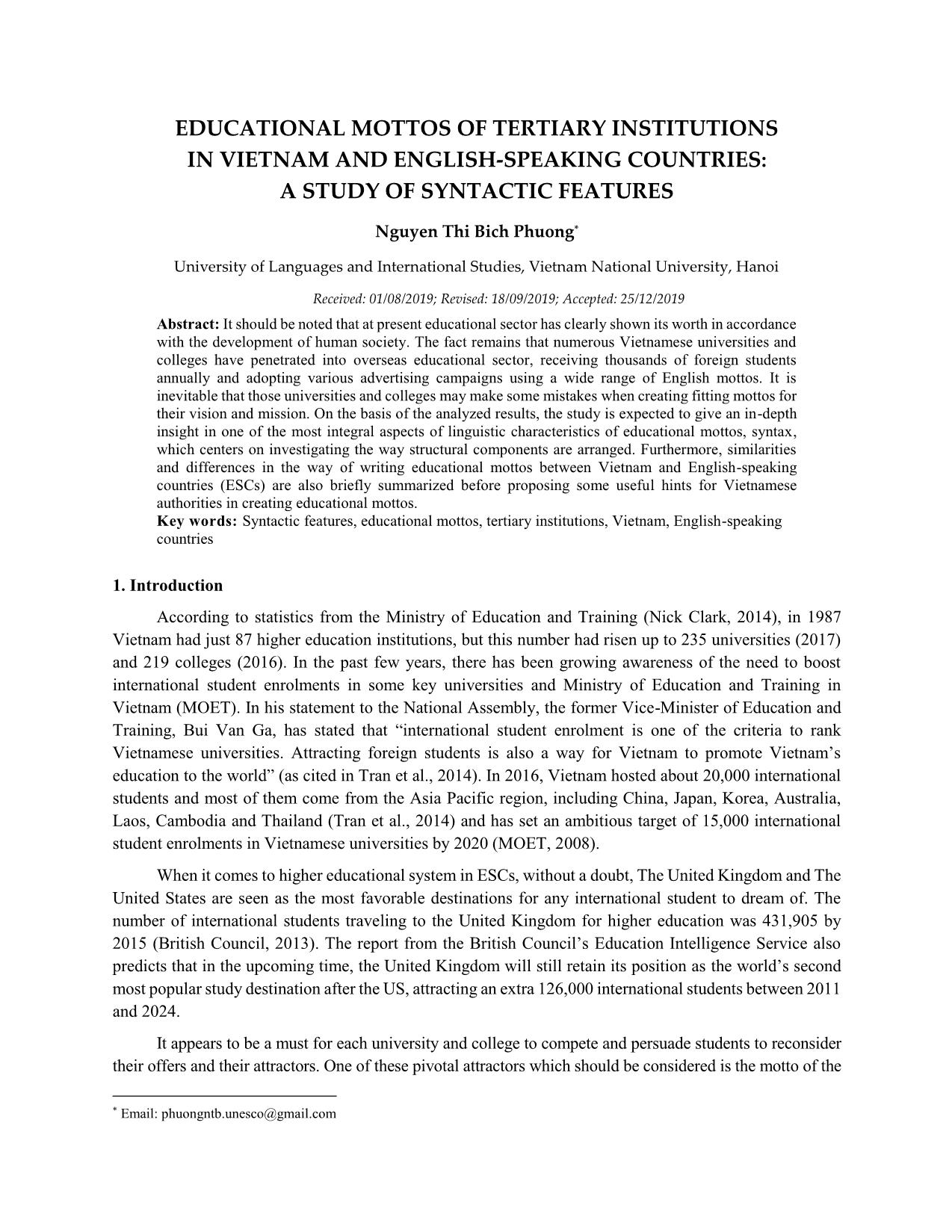
Trang 1
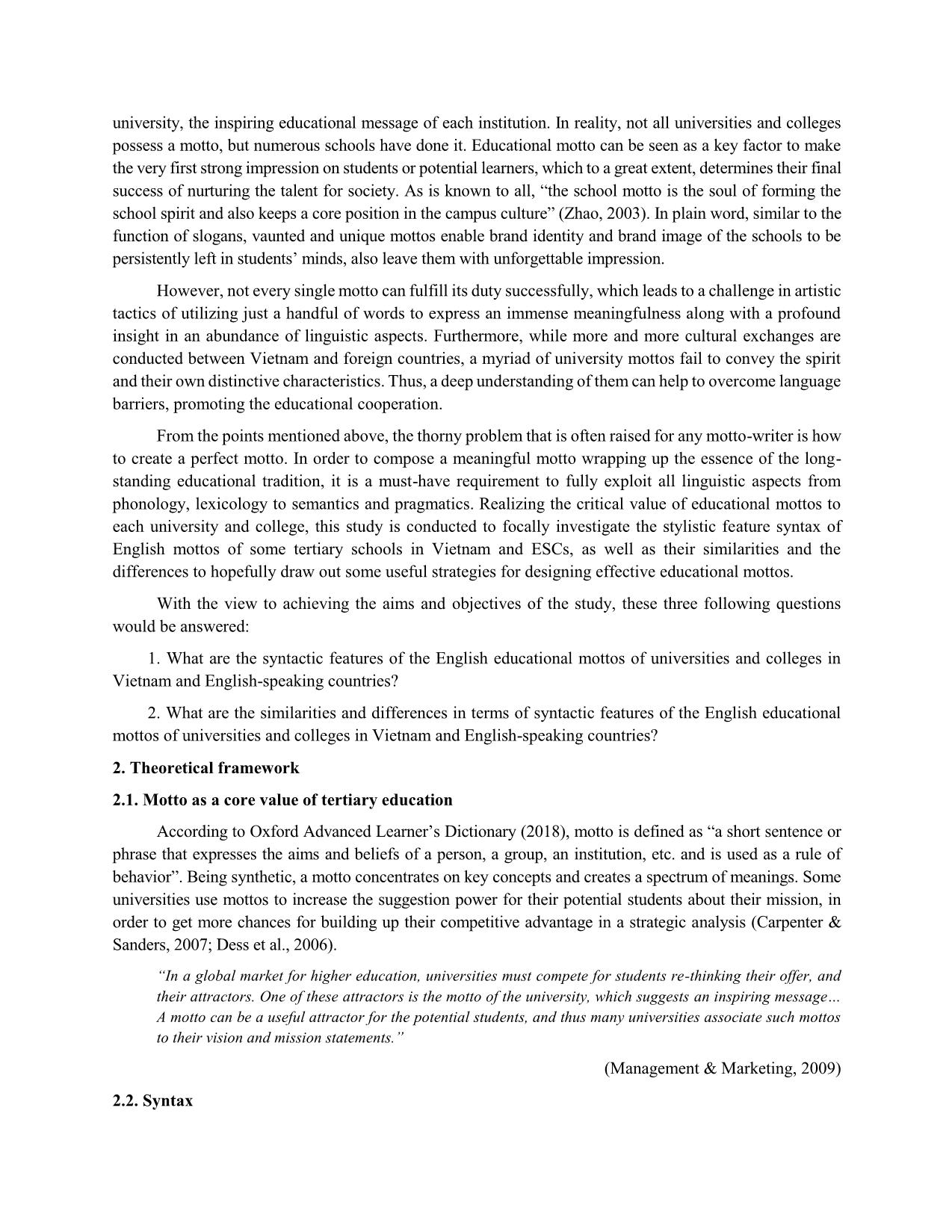
Trang 2
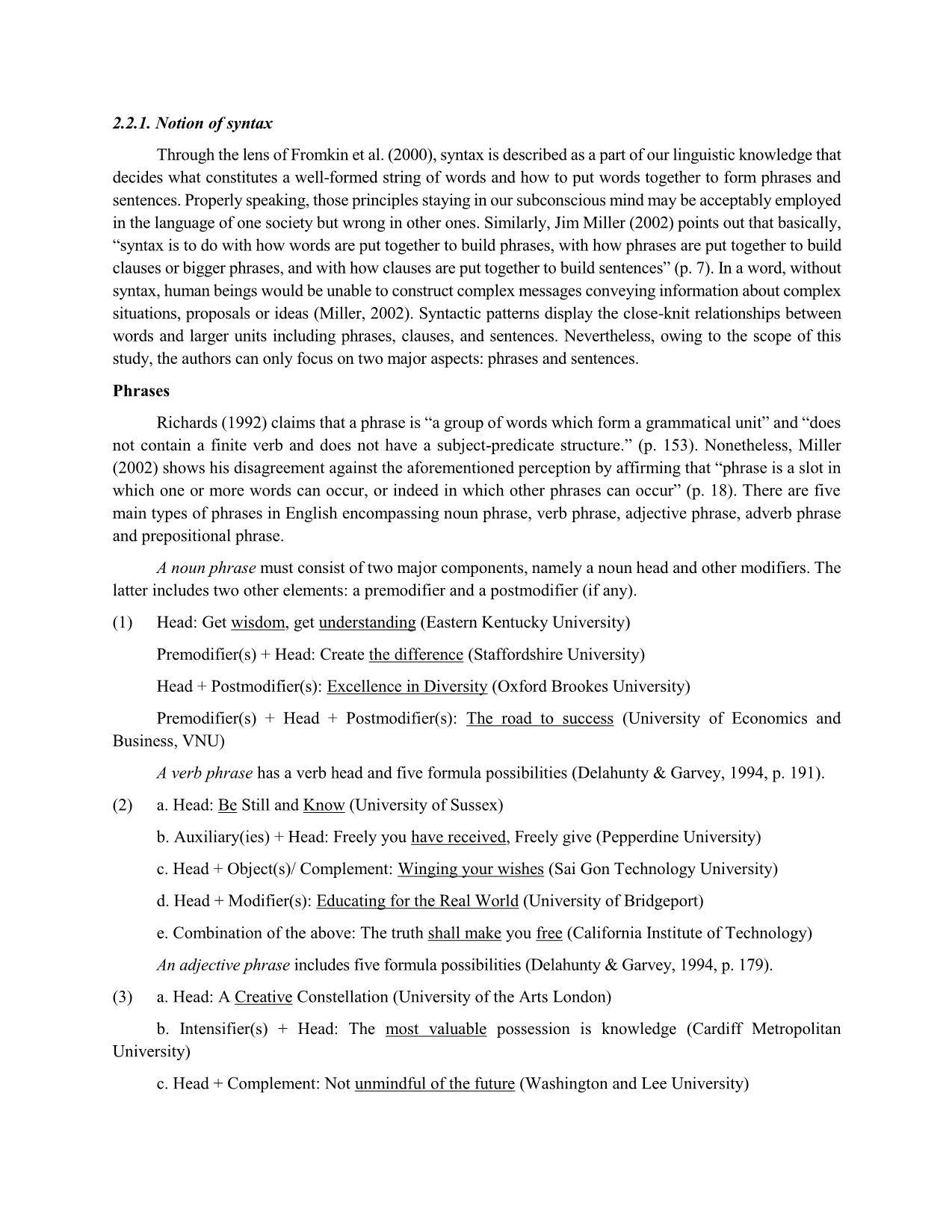
Trang 3
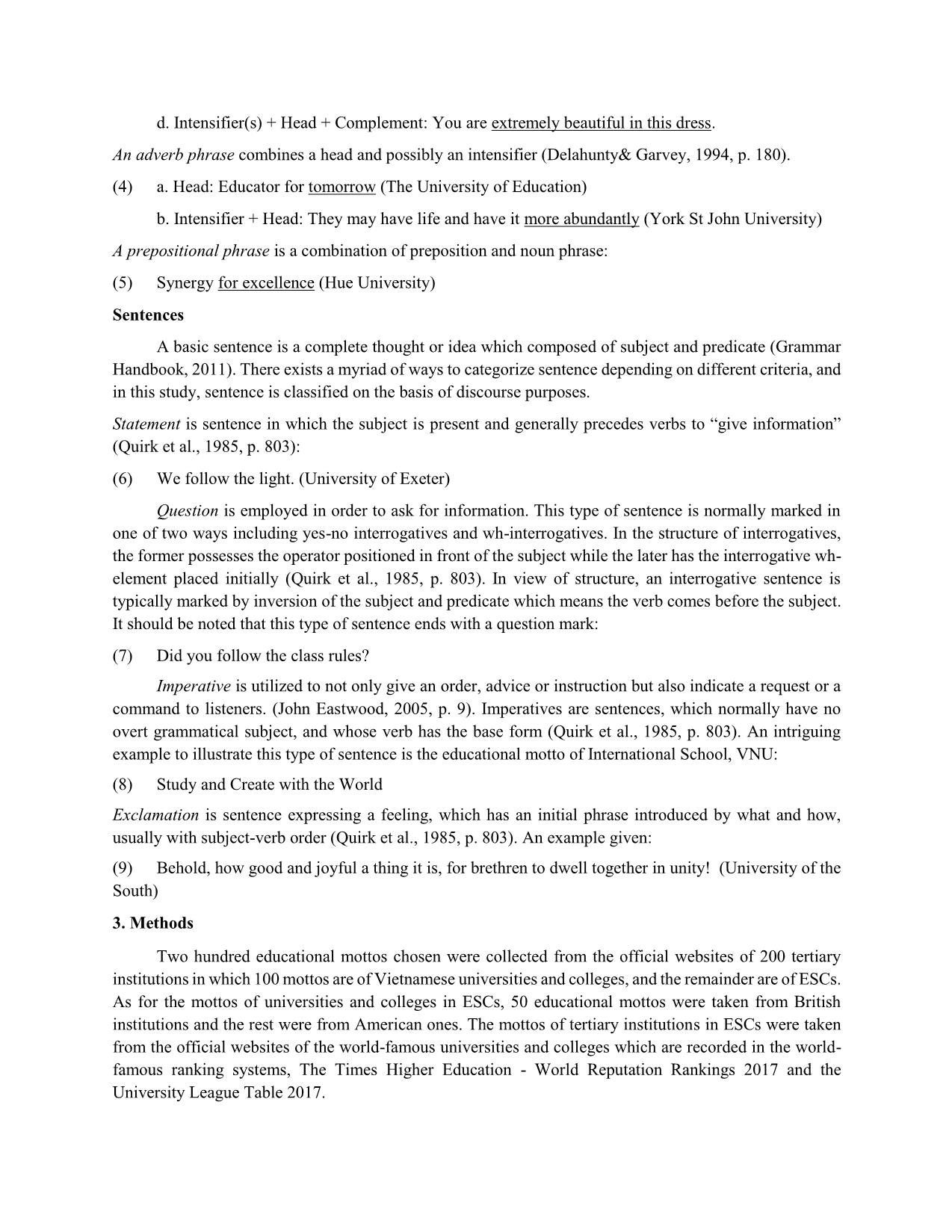
Trang 4
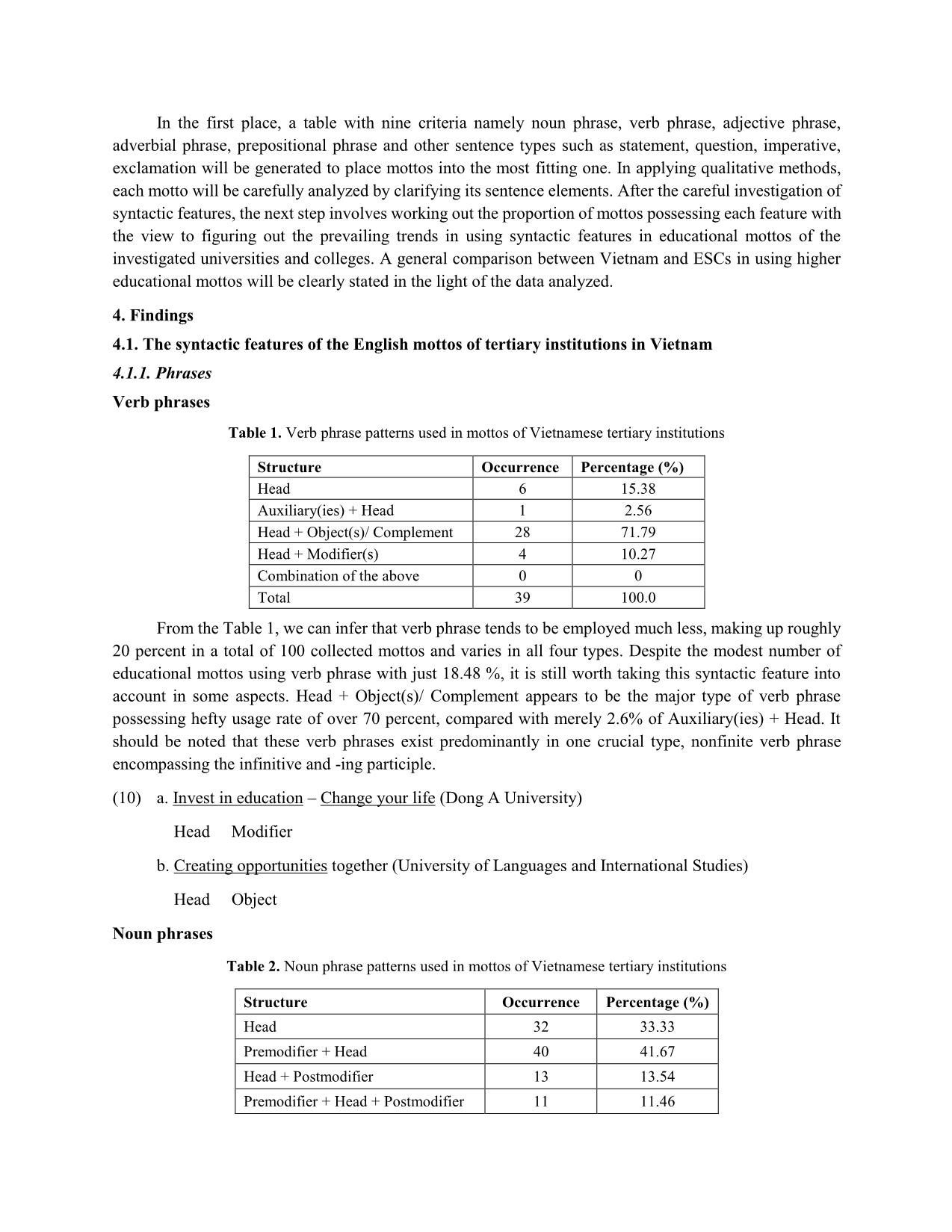
Trang 5
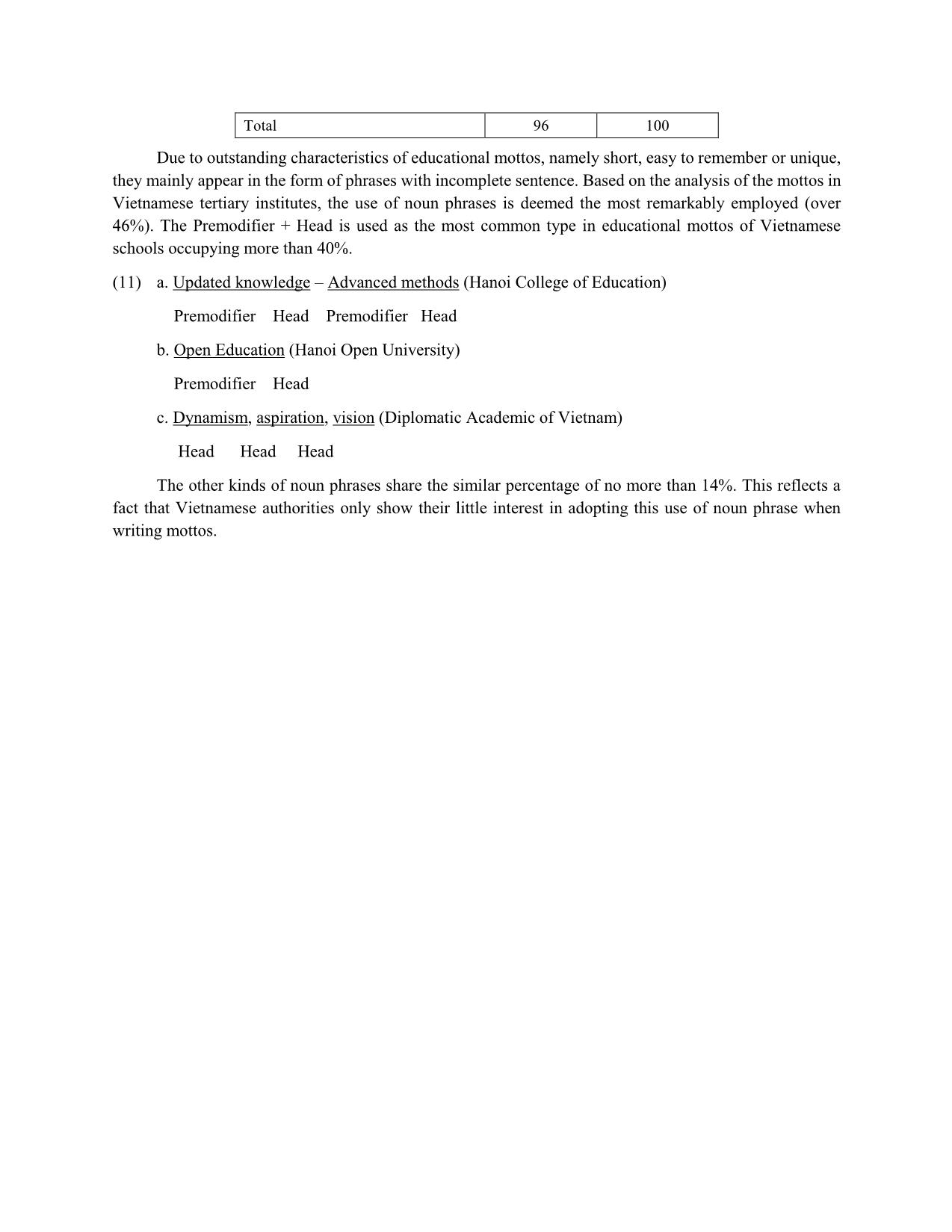
Trang 6
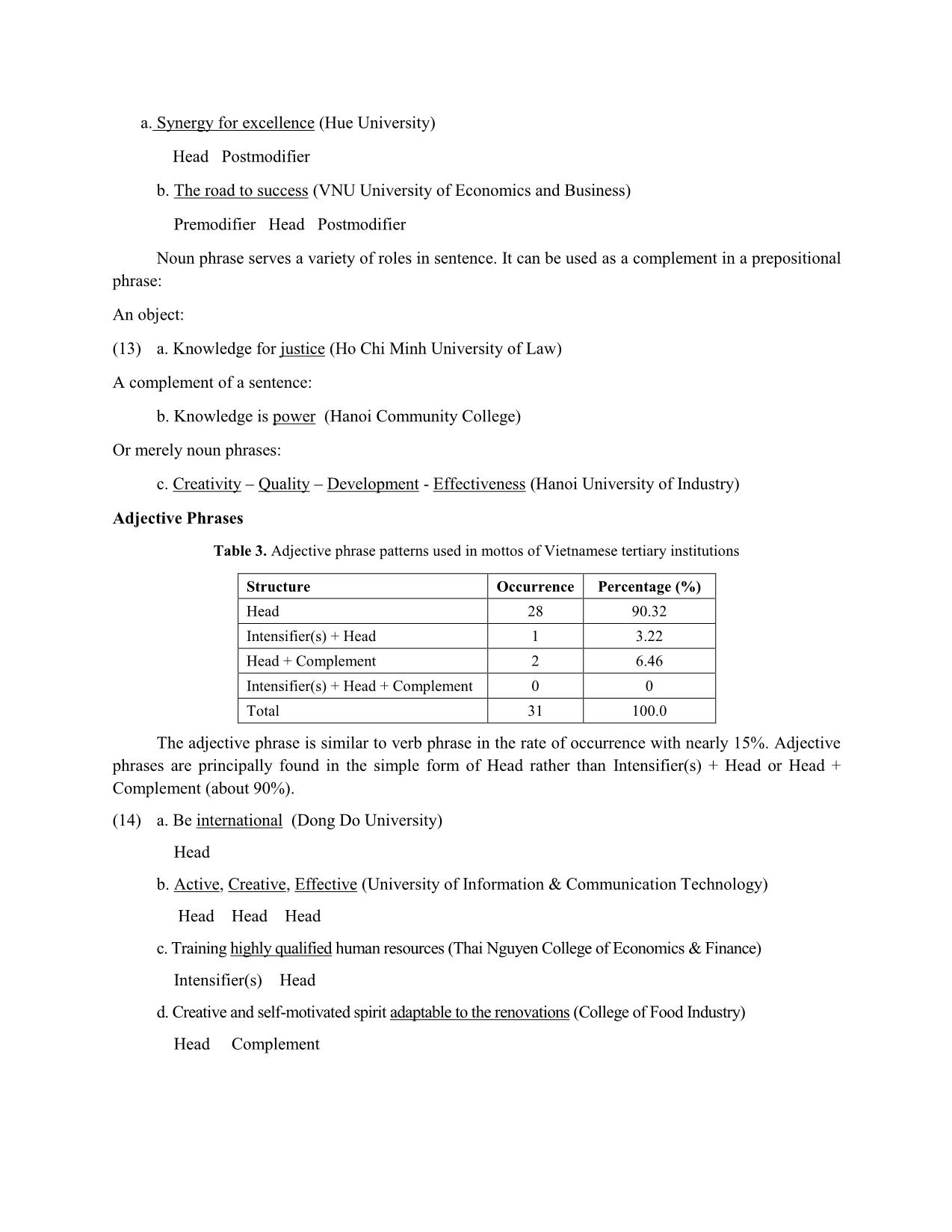
Trang 7
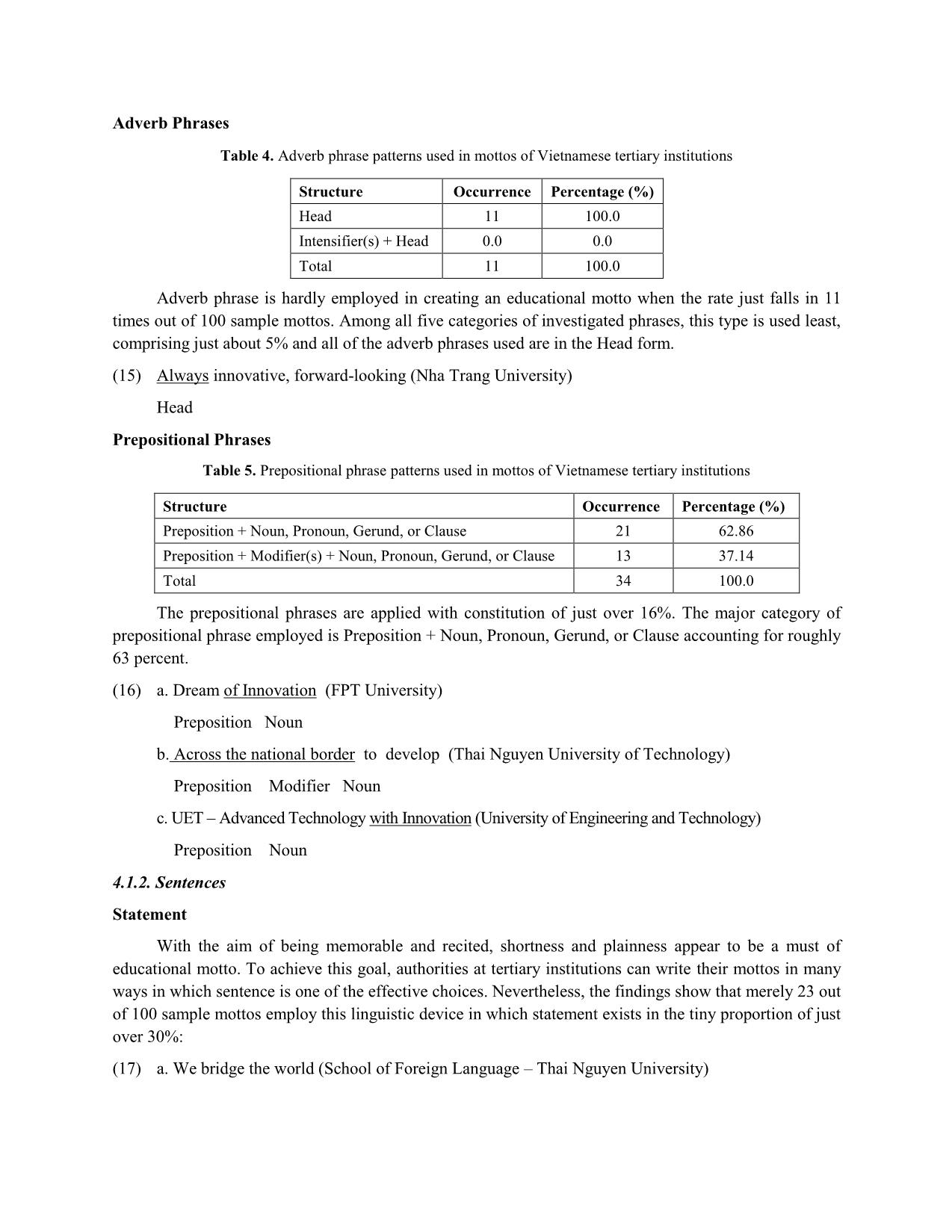
Trang 8
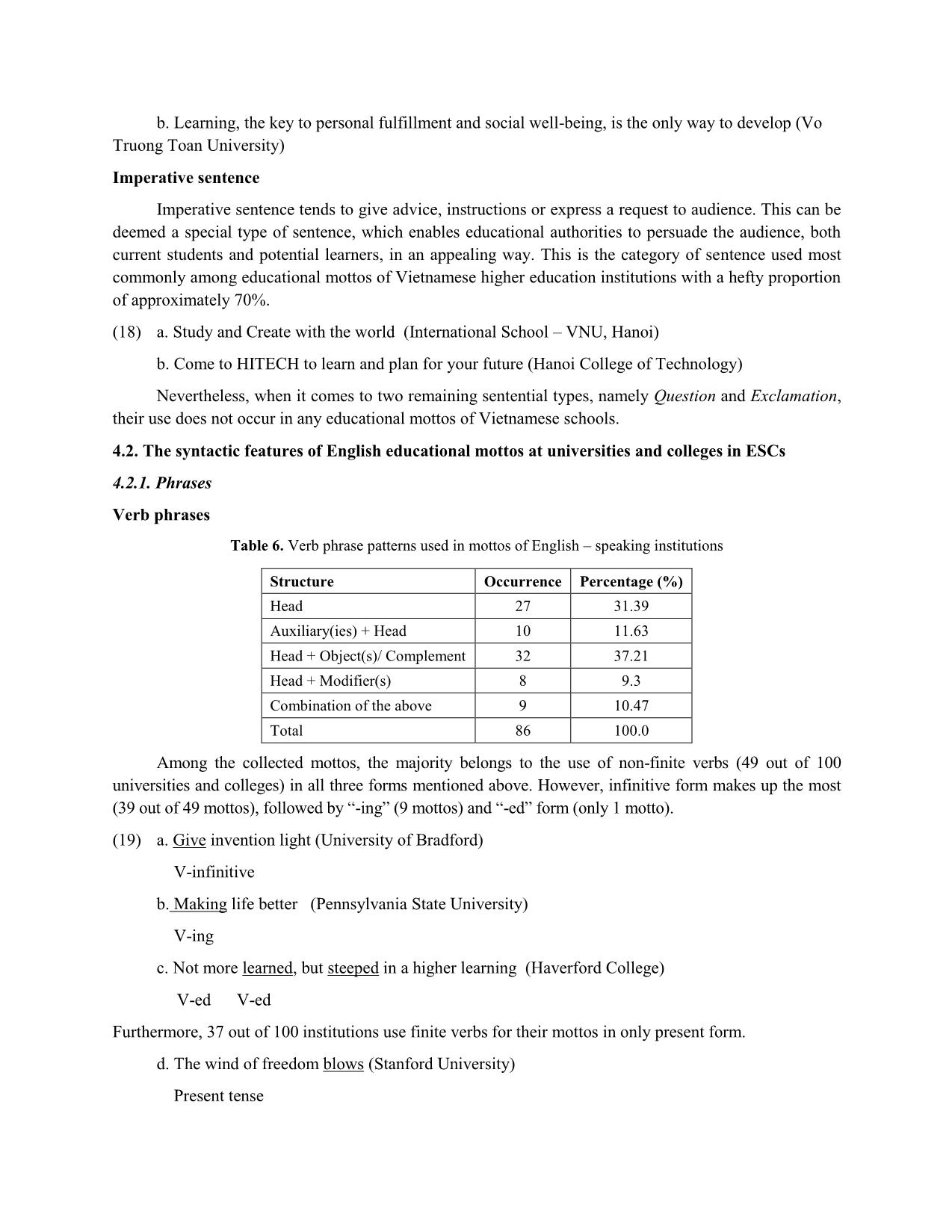
Trang 9

Trang 10
Tải về để xem bản đầy đủ
Tóm tắt nội dung tài liệu: Educational mottos of tertiary institutions in Vietnam and English-Speaking countries: A study of syntactic features
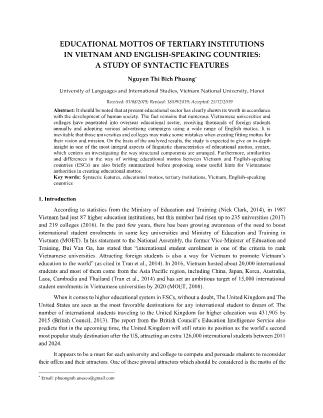
e to limit of space, it virtually appears to have no room for longer and more complicated noun phrases or elaborated sentences. According to Bruthiaux (1996, p. 80-81), the fact that heavy modification of noun phrase springs from spatial and financial constraints which help to minimize the number of function words lead to the frequent use of heavy modification. In this study, it is particularly the form: Premodifier + Head. For the sake of attracting students’ attention, mottos are found with the main use of adjectives and nouns to modify head nouns. As shown in the chart above, universities and colleges of ESCs deem verb phrase a predominant type in writing educational institution mottos, accounting for 43%. Meanwhile, this usage is less observed in mottos of Vietnamese institutions with merely over 18%. In advertising, verbal groups are mostly of maximum simplicity, consisting of only one word (Leech, 1996). In addition, the marked frequency of using progressive forms in mottos of ESCs can probably result from the intention of advertisers to mimic spoken language (Biber et al., 2002, p. 158). This assists the authorities to add a conversational quality to advertisement which can make the audience easily feel warm and familiar. Another noticeable observation is the propensity of authorities to omit the subject and auxiliary in the progressive phrase to become non- finite, for instance “Shaping futures” (Nottingham Trent University). The reason is that students are supposed to form a virtual link between the implied subject of universities and colleges and mottos, which enables schools to remove it without misinterpretation. Also be concluded from the analysis of noun phrases, verb phrases are quite commonly used due to the limit on spatial and financial constraints. Other categories of phrases seem to be unremarkable and much less commonly used. Regarding adjective phrase, while its usage makes up only 9.5% in the mottos of ESCs, Vietnamese universities and colleges employ this linguistic feature more popularly, but with merely 15%. One reason for this fact may arise from the preference of using noun phrase with adjective modification. Hence, in sample mottos, adjectives just play a supplement role in noun phrase. Concerning prepositional phrases, they account for over 16% and 12% in mottos of Vietnam and ESCs respectively. Prepositional phrases on educational institution mottos are aimed to inform the readers of the vision or the missions, so readers can be attracted if they are told what they will get from tertiary education. For example, the motto “The Road to Success” (University of Economics and Business) tells the readers that the school will assist students to obtain a successful career in the future. However, not many authorities think that prepositional phrases are strong enough to fascinate the target audience. The least used phrases are adverb ones with roughly 5% in both Vietnam and ESCs. In general, adverbs are functioned as the modifiers in a sentence or to give further particulars about certain conditions. For instance, the word “freely” in “Freely you have received, Freely give” (Pepperdine University) will explain how you receive and give. However, it was found that adverb phrases do not always become the modifiers to the other lexical categories. In mottos, adverb phrases can stand alone as the main phrase to give further explanation about the universities and colleges. In light of the abovementioned analysis, one can conclude that universities and colleges in Vietnam are strongly in favor of using noun phrases in creating motto, while those in ESCs pay much more attention to verb phrases. Nonetheless, they all somewhat share the same preference for adopting adjective phrases, adverb phrases and prepositional phrases when writing mottos. The use of nouns helps to save space and time in advertisements or other related activities. This is absolutely beneficial when the audience can be well informed and easily receive the imparted messages. Meanwhile, verb phrase assists school authorities to add a conversational quality to the educational motto which can create a friendly, warm atmosphere and a close relationship between the institutions and the audience. Plus, verb phrases are also used quite commonly due to spatial and financial constraints. 5.2. Sentences Figure 3. The frequency of sentences in mottos of in both Vietnam and ESCs Figure 4. The frequency of sentences in mottos of in Vietnam and ESCs As can be seen from Figure 3, the most frequently used type of sentence is imperative sentence with the proportion of over 50%. It is not surprising that the authorities would employ imperative sentences to create a motto since this is the most direct way to achieve the ideal effects. In particular, in Vietnamese institutions, imperative sentence appears to be predominance with around 70%. Leech (1966) argues that the reason for the ubiquitous utility of imperative sentence is deemed the audience’s familiarity with the road signs, official forms and instructions. However, the tendency of applying this category in Vietnam is contrary to that in ESCs. It is evident that the figure for imperative sentence in ESCs nearly doubles that of Vietnamese institutions (28 versus 16 mottos). The reason for this may be the diverse use of other categories in Vietnam. In terms of statement, which ranks second in the frequency of using in both Vietnamese and English- speaking universities and colleges with about 48%, the trend is different. To be more specific, the percentage in using statements of tertiary institutions in ESCS makes up roughly 54%, which is almost twice as much as that in Vietnam. Regarding statement, simple sentences are the most frequently used type because with well-composed simple sentences, the information imparted to readers will be succinct and coherent. Additionally, simple sentences are easy to remember, while one main aim of a motto is to be memorable and recited. Hence, statements, especially simple sentences are more reader-friendly and commonly applied in advertisements in general and in educational school mottos in particular. Another category is question, making up only over 1% in both Vietnam and ESCs. Leech (1966) stated one of the functions of interrogative sentence in advertisements is to draw the audience’s attention by raising questions, especially rhetorical questions. This approach may have merits as well as drawbacks; therefore, it might be considered one minor reason why questions are less used in educational school mottos. Last but not least, it can be seen that exclamation is not used in any educational school mottos of universities and colleges in both Vietnam and ESCs. There is no doubt that exclamation is a sentence expressing a strong feeling; as a result, it is not suitable for serving educational institution mottos which transmit the educational vision and mission of the universities and colleges. In a nutshell, on the one hand, both Vietnamese and English-speaking universities and colleges tend to make little use of question and exclamation. On the other hand, imperative sentence appears to be a major element employed in the mottos of tertiary institutions in Vietnam, whereas statement contributes the highest percentage in the frequency of using in ESCs. The notion to explain this result is that imperative sentence is applied to express the determination and commitment to achieve the set goals of the whole university. This type of short and concise sentence creates persuasion, serving for the purpose of boosting the learning spirit of students to try harder for their learning cause. In terms of the sentential type of statement, the main aim is to illustrate the visions and missions of schools, giving much more motivations for their students to pursue their study path. Furthermore, those facts can be also seen as reasons for them to enrol into universities and colleges. This study aims at providing some critical insights in syntactic features of mottos, from which students can expand their understanding in the field of advertising mottos. Particularly for ones who work with advertising agency, this theory gives ways to understand structure of a motto and offers some techniques for them to write a successful motto in English to attract students’ attention. As for teachers, they can take advantage of this study to understand not only the background information of advertising and mottos, but they also can gain a profound insight in syntactic aspects including phrases and sentences. Hence, they can apply knowledge as well as sample mottos as examples from this study to explain to students during the process of teaching. When it comes to Vietnamese tertiary institutes, this work creates an opportunity for these universities and colleges to have a deeper understanding in the structure of each kind of mottos. In particular, structure and the use of phrases and sentences are two major elements that can be attained through this study. In that way, tertiary institutions will easily make decisions on which kind of phrases or sentences is suitable and brings success to their reputation. 6. Conclusion It is worth noting that Vietnamese universities and colleges have tendency to use noun phrases in mottos whereas those in ESCs show their preference for adopting verb phrases. The use of nouns helps to save space and time in advertisements. This is absolutely beneficial when the audiences can be well informed and easily receive the delivered messages. Meanwhile, verb phrases assist school authorities to add a conversational quality to the educational mottos, which can create a friendly warm atmosphere and a close relationship between the tertiary institutions and the audience. What is more, verb phrases are also applied quite commonly due to the limit on spatial and financial constraints. Nonetheless, all universities and colleges in Vietnam and ESCs, to a certain extent, share the same preference for adopting adjective phrases, adverb phrases and prepositional phrases when creating mottos. Regarding sentences, statements tend to hold up the majority in the frequency of occurrence in ESCs thanks to its being more reader-friendly and going straight to the audience’ mind, while those in Vietnam give their preference to imperative sentences due to the audience’s familiarity with the road signs, official forms and instructions. However, both Vietnamese and English-speaking universities and colleges tend to make little use of questions and exclamations. Due to time constraint, this research has only investigated 200 educational institution mottos, which makes the results become less generalized. Hence, a larger population of samples is recommended to generate more precise results. Also, the scope of study on syntactic features can be implemented in other fields, not merely limited in tertiary education mottos. References Biber, D., Conrad, S., & Leech, G. (2002). Longman student grammar of spoken and written English. Harlow: Longman/Pearson Education Limited. Bộ Giáo Dục và Đào Tạo (Ministry of Education and Training, MOET) (2008). Chiến lược phát triển giáo dục 2009-2020 (Vietnam’s strategy for education development 2009-2020). Hanoi, Vietnam. British Council (2013). The future of the world’s mobile students to 2024. British Council, London. Bruthiaux, P. (1996). Discourse of classified advertising: Exploring the nature of linguistic simplicity. Cary, North Carolina: Oxford University Press. Carpenter, M.A., & Sanders, W.G. (2007). Strategic management: A dynamic perspective. Upper Saddle River, NJ: Pearson Prentice Hall. Clark, N. (2014). Higher education in Vietnam. World Education News & Reviews. Retrieved from: College (2018). In Dictionnarycambridge.org. Retrieved from: https://dictionary.cambridge.org/dictiona ry/english/college. Delahunty, P.G., & Garvey, J.J. (1994). Language, grammar, and communication. A course for teachers. New York: Mcgraw-Hill College. Eastwood, J. (2005). Oxford learner's grammar: Grammar finder. Oxford: Oxford University Press. Fromkin, A.V. (2000). Linguistics: An introduction to linguistic theory. Oxford: Blackwell. Leech, G.N. (1996). English in advertising: A linguistic study of advertising in Great Britain. London: Longman. Miller, J. (2002). An introduction to English syntax. Edinburgh: Edinburgh University Press. Motto (2018). In Oxfordlearnersdictionaries.com. Retrieved from: https://www.oxfordlearnersdictionar ies.com/definition/english/motto?q=motto. Quirk, R., Greenbaum, S., Leech, G., & Svartvik, J. (1985). A comprehensive grammar of the English language. London: Pearson Longman. Richards, J.C., Platt, J., & Platt, H. (1992). Longman dictionary of language teaching and applied linguistics. London: Longman. Tran, L., Marginson, S., Do, H., Le, T., Nguyen, N.T., Vu, T., & Pham, T. (2014). Higher education in Vietnam: Flexibility, mobility and practicality in the global knowledge economy. Hampshire: Palgrave Macmillan. U.S. Department of Education, National Center for Education Statistics (2013). Digest of Education Statistics 2012 (NCES 2014-015). Retrieved from: https://nces.ed.gov/pubs2014/2014015.pdf. University (2018). In Dictionnarycambridge.org. Retrieved from: https://dictionary.cambridge.org/dictio nary/english/university. Zhao, J.Z. (2003). Brief comment on school motto of colleges and universities. Journal of Luoyang University. Retrieved from: KHẨU HIỆU GIÁO DỤC ĐẠI HỌC TẠI VIỆT NAM VÀ CÁC NƯỚC NÓI TIẾNG ANH: NGHIÊN CỨU DƯỚI GÓC NHÌN TỪ ĐẶC TRƯNG CÚ PHÁP Tóm tắt: Hiện nay nền giáo dục đang ngày càng thể hiện rõ vị thế của mình trong quá trình phát triển của xã hội. Thực tế cho rằng rất nhiều trường đại học, cao đẳng của Việt Nam đang nỗ lực vươn mình ra tầm quốc tế, thu hút hàng nghìn sinh viên nước ngoài tới theo học mỗi năm, đồng thời áp dụng nhiều chiến dịch quảng bá hình ảnh, trong đó có sử dụng các khẩu hiệu giáo dục. Tuy nhiên, các trường đều thật khó tránh khỏi những sai sót trong quá trình định hình khẩu hiệu giáo dục phù hợp với tầm nhìn và sứ mệnh của mình. Dựa trên kết quả phân tích, bài nghiên cứu đưa ra một cái nhìn có chiều sâu về một trong những khía cạnh ngôn ngữ quan trọng nhất trong khẩu hiệu giáo dục, đó chính là cú pháp, tập trung nghiên cứu sự sắp xếp của các thành tố ngôn ngữ. Hơn nữa, đặc điểm giống và khác nhau về cách viết khẩu hiệu giáo dục của các trường đại học, cao đẳng ở Việt Nam và các nước nói tiếng Anh cũng được chỉ ra cùng với những gợi ý cho các trường khi viết khẩu hiệu giáo dục. Từ khóa: Đặc điểm cú pháp, khẩu hiệu giáo dục, đại học và cao đẳng, Việt Nam, các nước nói tiếng Anh
File đính kèm:
 educational_mottos_of_tertiary_institutions_in_vietnam_and_e.pdf
educational_mottos_of_tertiary_institutions_in_vietnam_and_e.pdf

